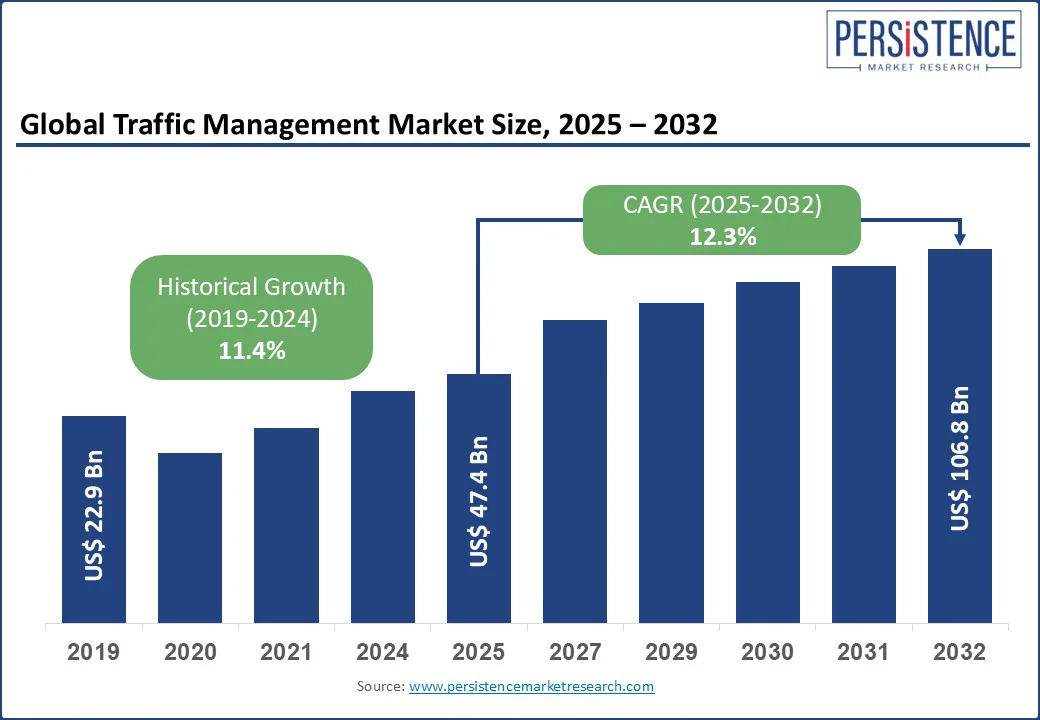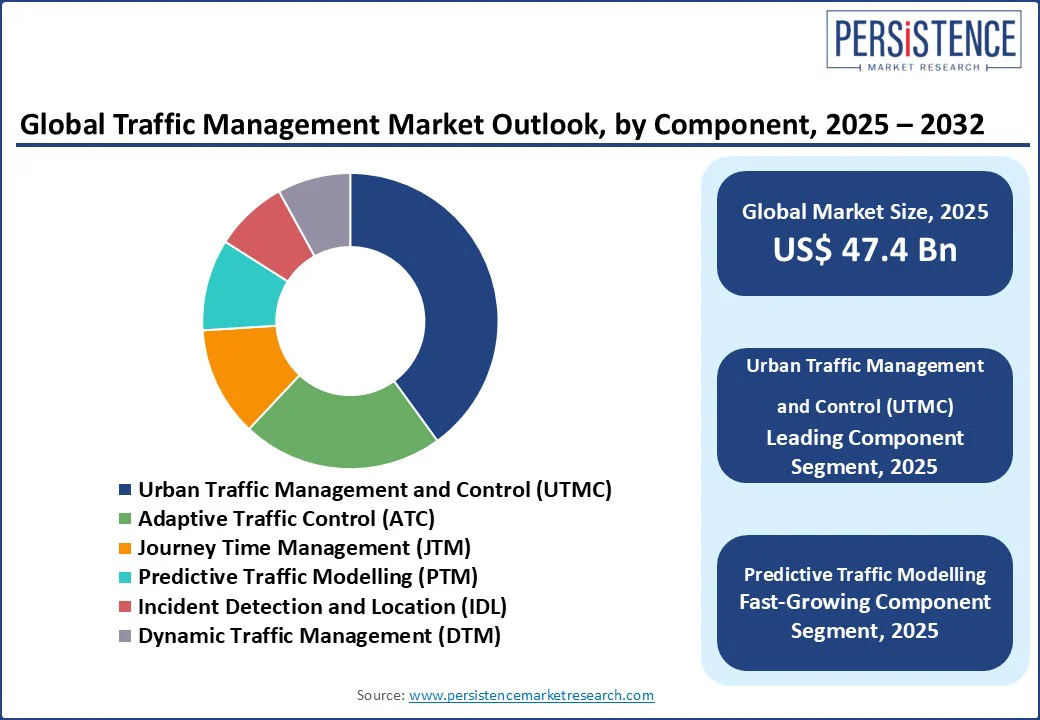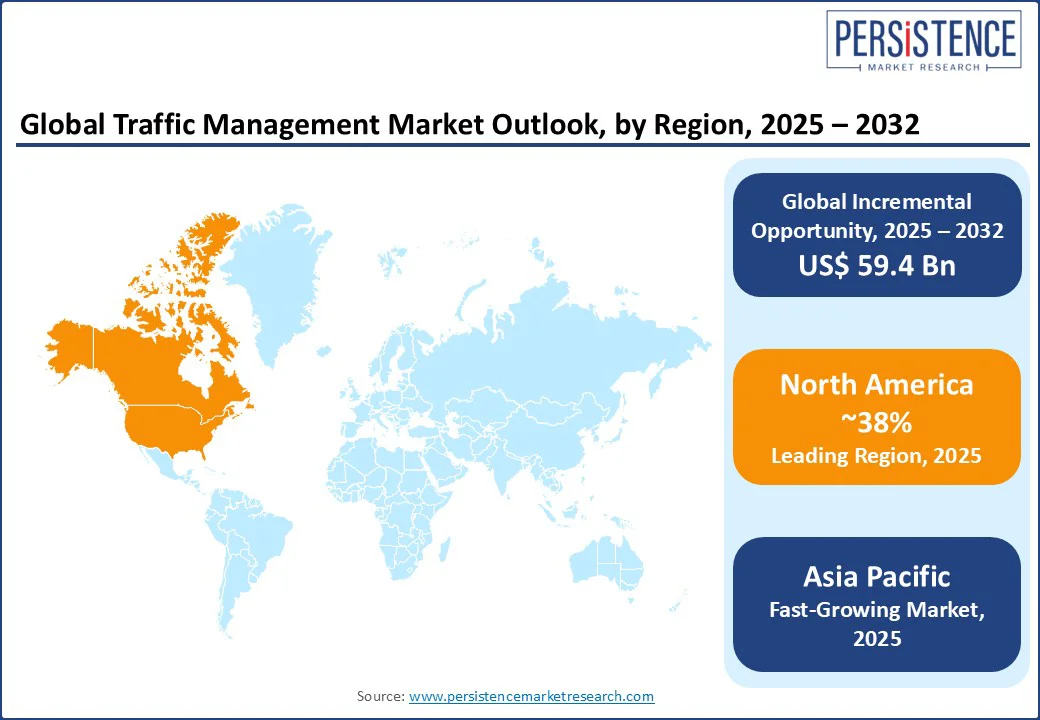ID: PMRREP3847| 200 Pages | 12 Aug 2025 | Format: PDF, Excel, PPT* | IT and Telecommunication

The global traffic management market size is likely to be valued at US$47.4 Bn in 2025 to US$106.8 Bn by 2032, exhibiting a CAGR of 12.3% during the forecast period from 2025 to 2032. The Traffic Management market is experiencing steady growth, driven by increasing urbanization, rising vehicle ownership, and the adoption of smart city initiatives. Traffic management systems, valued for their ability to optimize traffic flow, enhance road safety, and reduce congestion, are increasingly adopted by governments and municipalities.

Key Industry Highlights
|
Global Market Attribute |
Key Insights |
|
Traffic Management Market Size (2025E) |
US$ 47.4Bn |
|
Market Value Forecast (2032F) |
US$ 106.8.Bn |
|
Projected Growth (CAGR 2025 to 2032) |
12.3% |
|
Historical Market Growth (CAGR 2019 to 2024) |
11.4% |
The rapid pace of urbanization and the global push for smart city initiatives are key drivers. With urban populations projected to reach 6.7 Bn by 2050, according to the United Nations, cities face increasing traffic congestion, necessitating advanced traffic management systems. For instance, Singapore’s Land Transport Authority (LTA) and Intelligent Transportation Society Singapore (TSS) implemented the Smart Mobility 2030 plan, integrating AI and IoT to optimize traffic flow.
In countries such as China and India, where urban vehicle ownership grew by 12% in 2024, according to the International Transport Forum, solutions such as adaptive traffic control and real-time analytics are critical. These systems reduce congestion in cities such as Beijing, enhancing mobility and sustainability. The integration of 5G technology further enables real-time data exchange, allowing traffic authorities to make informed decisions, driving market growth through 2032.
High initial investment and operational costs pose significant challenges, particularly in developing regions. Deploying advanced systems, such as those from Siemens AG and Kapsch TrafficCom, requires substantial spending on hardware such as sensors and cameras, often exceeding $100,000 per intersection, according to the International Transport Forum. Additionally, software licensing and integration costs rose in 2023 due to complex system requirements, per the Global Traffic Management Association. Maintenance of IoT-enabled devices and cybersecurity measures further escalates costs, straining smaller municipalities. Consumer and government concerns about funding allocation in price-sensitive markets also hinder scalability, as prioritizing basic infrastructure often overshadows advanced traffic solutions, slowing market penetration in less-developed regions.
The increasing adoption of AI and IoT-driven traffic management solutions presents significant opportunities for market growth. These technologies enable real-time data collection and analysis, improving traffic flow and safety. For instance, in 2024, Dubai’s Roads and Transport Authority implemented AI-based traffic systems, reducing congestion, according to the Dubai RTA.
Government initiatives, such as India’s Smart Cities Mission, promote AI and IoT integration across 100 cities, boosting demand for solutions such as predictive traffic modeling. Companies such as Cisco Systems and Iteris Corporation are developing cloud-based platforms to enhance scalability, enabling municipalities to optimize traffic without extensive infrastructure overhauls. The trend toward sustainable mobility, with consumers demanding eco-friendly solutions, allows manufacturers to innovate, capturing a growing segment of smart urban markets through 2032.

North America, accounts for approximately 38% of the global traffic management market share in 2025, driven by advanced IT infrastructure and high investment in intelligent transportation systems in the U.S. and Canada. Companies such as Cisco Systems, Inc. and Iteris Corporation dominate, offering solutions such as smart signaling and traffic analytics. The U.S. Department of Transportation invested $2.5 Bn in 2024 to enhance traffic management, per USDOT reports. Urbanization and rising vehicle ownership, coupled with early adoption of smart city initiatives, are key drivers, with cities such as Los Angeles implementing ATC systems to reduce congestion.
Asia Pacific is the fastest-growing region, driven by rapid urbanization, government-led smart city initiatives, and increasing traffic congestion in China and India. In 2024, sales of traffic management systems grew, supported by brands such as Sumitomo Electric Industries and LG CNS Co., Ltd., expanding in urban centers. India’s Smart Cities Mission, targeting 100 cities, and China’s investments in AI-driven traffic solutions in Beijing are key growth drivers. The region’s urban population, reaching 3.4 billion in 2024, per the United Nations, fuels demand for advanced traffic systems.
Europe, the second fastest-growing region, is propelled by stringent regulations on emissions and urban mobility, alongside widespread adoption of UTMC systems. Countries such as Germany and the UK lead, with companies such as Siemens AG and SWARCO AG deploying advanced traffic management solutions in cities such as Munich and London. The EU’s Green Deal, aiming for carbon neutrality by 2050, supports investments in smart traffic systems, driving market growth through sustainable urban mobility initiatives.

The Global Traffic Management market is highly competitive, with global leaders such as Siemens AG, SWARCO AG, and Cubic Corporation dominating through innovative solutions and extensive networks. Regional players such as LG CNS Co., Ltd. and Jenoptik AG focus on localized offerings and AI-driven systems. Companies are investing in R&D to develop sustainable, scalable solutions, with a focus on IoT and cloud-based platforms to meet the growing demand for smart urban mobility.
The Traffic Management market is projected to reach US$47.4 Bn in 2025.
Rapid urbanization and smart city initiatives are the key market drivers.
The Traffic Management market is poised to witness a CAGR of 12.3% from 2025 to 2032.
The growing adoption of AI and IoT-driven traffic solutions is the key market opportunity of the Traffic Management Market.
Siemens AG, SWARCO AG, and Cubic Corporation are among the key market players of the Traffic Management Market.
|
Report Attribute |
Details |
|
Historical Data/Actuals |
2019 - 2024 |
|
Forecast Period |
2025 - 2032 |
|
Market Analysis Units |
Value: US$ Bn/Mn, Volume: As Applicable |
|
Geographical Coverage |
|
|
Segmental Coverage |
|
|
Competitive Analysis |
|
|
Report Highlights |
|
|
Customization and Pricing |
Available upon request |
By Component
By System
By Region
Delivery Timelines
For more information on this report and its delivery timelines please get in touch with our sales team.
About Author